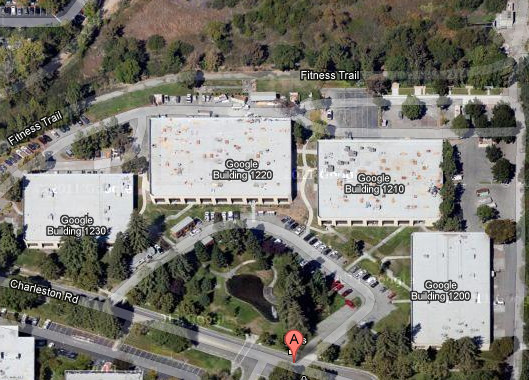Google’s Private Cell Phone Network
Filings made with the U.S. Federal Communications Commission reveal that Google wants to start operating its own, very small cell phone network on its Mountain View campus. It’s the latest in a series of hints in recent years that Google is unsatisfied with the way that mobile networks control the mobile Internet.

Google tells the FCC it wants to install up to 50 mobile base stations in buildings on the Western edge of Google’s Mountain View campus, just a block or so away from its main Android building. Up to 200 mobile devices will be used on that “experimental” network and the area covered will be small, with indoor base stations reaching only up to 200 meters, and any outdoors ones reaching no further than a kilometer. The WSJ reports that the frequencies used belong to ClearWire, and aren’t compatible with any U.S. mobile device. They are in use in China, Brazil, and India, though.
Google might just be experimenting with devices for those parts of the world. Or it might be trying something more radical. The search and ad giant has been rumored to be exploring the idea of working with TV provider Dish to launch a wireless Internet service, has already got into the business of providing broadband (see “Google’s Internet Service Might Bring the U.S. Up to Speed”), and has a history of showing interest in ideas that would loosen the grip of cellular providers on mobile devices and what people can do with them.
Google lobbied U.S. regulators to encourage them to open up unused TV spectrum into so-called “white spaces,” as they did in 2009, allowing that portion of the airwaves to be used by any company or device rather than being licensed exclusively to one company (see “Super Wi-Fi”). In 2008, the company filed a patent for an idea that would appall mobile networks—having mobile devices automatically hop to the cheapest cell network in an area rather than being locked to just one provider at all times.
Google’s biggest strike against the way wireless networks work today came in 2010 and was something of a flop. The company tried to break the U.S. convention of new mobile phones being tied to carrier contracts, only offering the flagship Nexus One smartphone online and unlocked. That experiment lasted only about six months, after Google struggled to cope with customer service requests and learned that U.S. consumers are apparently happier paying a significant markup for a device over two years than a smaller sum upfront.
Google has since played more nicely with cellular networks. Yet the relationships are still fraught, with fallings out over Google’s contactless payments system (blocked on Verizon handsets) and Android’s tethering function (also blocked by some carriers). It’s too early to know whether Google’s private cell phone network in Mountain View will add to that drama, but mobile networks are surely watching closely.
Keep Reading
Most Popular
How scientists traced a mysterious covid case back to six toilets
When wastewater surveillance turns into a hunt for a single infected individual, the ethics get tricky.
The problem with plug-in hybrids? Their drivers.
Plug-in hybrids are often sold as a transition to EVs, but new data from Europe shows we’re still underestimating the emissions they produce.
What’s next for generative video
OpenAI's Sora has raised the bar for AI moviemaking. Here are four things to bear in mind as we wrap our heads around what's coming.
Stay connected
Get the latest updates from
MIT Technology Review
Discover special offers, top stories, upcoming events, and more.